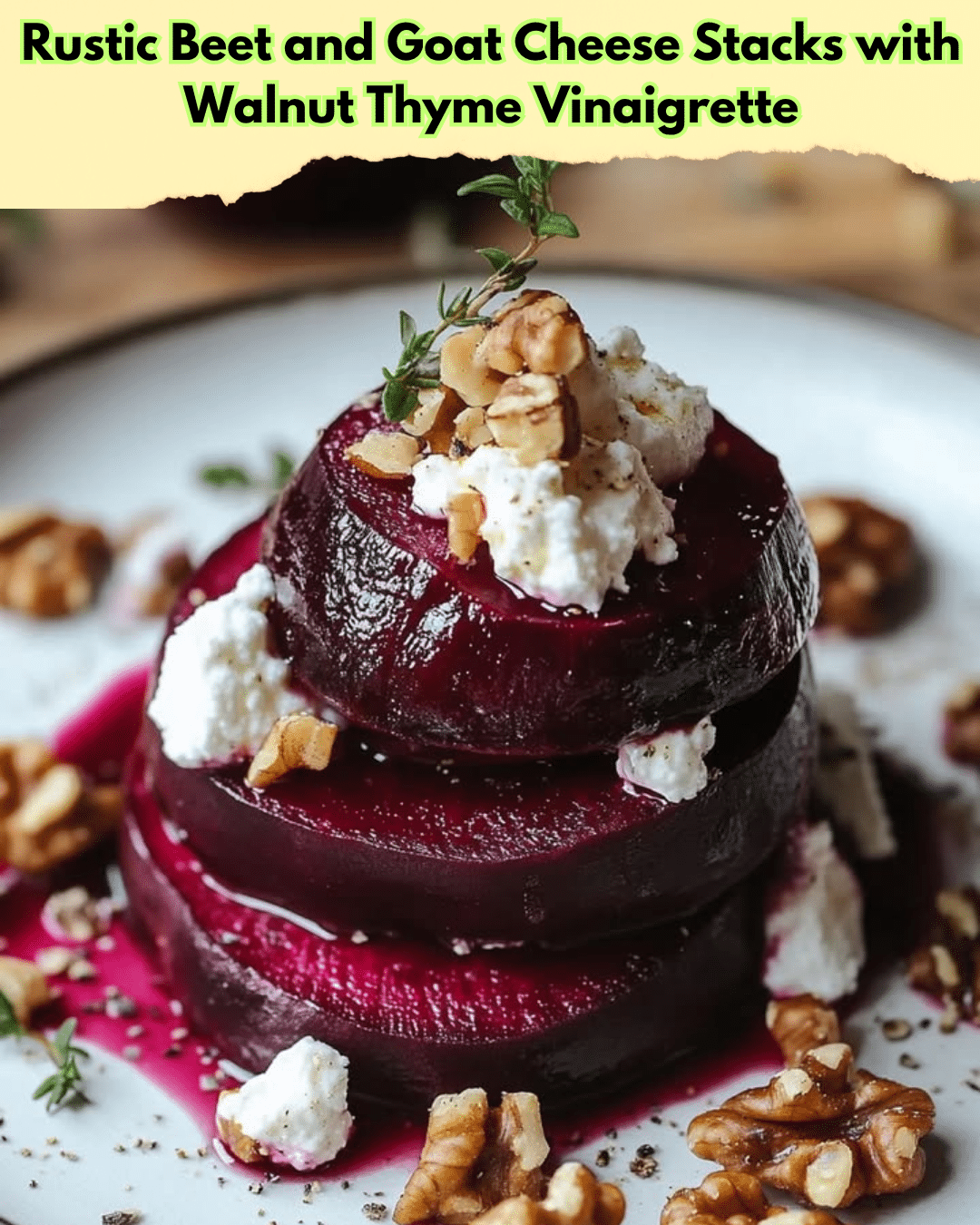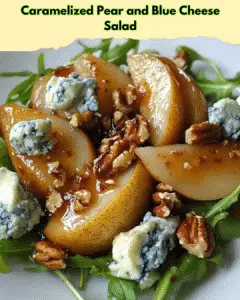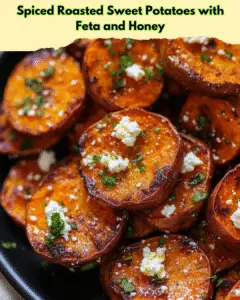Rustic Beet and Goat Cheese Stacks with Walnut Thyme Vinaigrette: A Flavorful Delight
Indulge your taste buds with this Rustic Beet and Goat Cheese Stacks with Walnut Thyme Vinaigrette recipe that exquisitely combines earthy beets and creamy goat cheese, drizzled with a fragrant vinaigrette. Set to impress your dinner guests, these stacks are not only visually striking but offer a delectable symphony of flavors. Each bite unveils the sweet, roasted taste of beets, complemented by the tangy creaminess of goat cheese and the rich nutty flavor of walnut vinaigrette with hints of thyme’s herbal aroma.
This sophisticated appetizer is perfect for those who appreciate the deeper, rustic flavors of farm-fresh produce. The natural sweetness of beets, roasted to perfection, contrasts beautifully with the luxurious smoothness of goat cheese. As the walnut thyme vinaigrette ties everything together, it imparts a complexity by providing a crunchy texture that vivifies every forkful. Easy to make ahead and laid back in its presentation, this dish promises texture and taste in every layer.
Quick Recipe Highlights
- Flavor Profile: The combination of earthy beets, creamy goat cheese, and nutty walnut vinaigrette creates a complex yet balanced flavor that is both rich and refreshing.
- Texture: Melt-in-your-mouth goat cheese paired with the crisp bite of roasted beets and the crunchy texture from toasted walnuts.
- Aroma: Inviting scents of roasting beets are accented by thyme’s fresh herbal essence, and the aroma of toasted nuts.
- Visual Appeal: These vibrant stacks capture the eye with layers of deep red beets and pure white goat cheese, dressed with a scattering of chopped nuts and a drizzle of vinaigrette.
- Skill Level Needed: Intermediate level is required to balance the roasting technique with the presentation of an elegant stack.
- Special Equipment: You will need a mandoline or sharp knife for thin and even slices, and a whisk for the vinaigrette.
Recipe Overview
- Difficulty Level: Intermediate—a moderate level of cooking experience will ensure the beets roast to perfect sweetness and that layers stack with precision.
- Category: This dish serves well as an appetizer or a light entrée, perfect for elegant gatherings or a refined, simple dinner.
- Cuisine: Rooted in European influences, it showcases rustic charm synonymous with Mediterranean cuisine.
- Cost: Focusing on seasonal and locally-sourced ingredients, the cost is modest with goat cheese and nuts as premium items.
- Season: Ideal in fall and winter, when beets are at their sweetest and most flavorful.
- Occasion: Perfect for dinner parties, holiday gatherings, or as a special treat for intimate evenings.
Why You’ll Love This Recipe
Discover the delightful blend of flavors and textures in these Beet and Goat Cheese Stacks with Walnut Thyme Vinaigrette. Taste the earthy yet subtly sweet note of roasted beets in contrast with the tanginess of goat cheese, which adds a rich, creamy layer to each bite. The walnut thyme vinaigrette provides a complex depth, adding a nutty essence and herbal aroma that dances on the palate. This dish transforms simple ingredients into an elegant composition that captivates both the eyes and the taste buds.
The convenience of pre-cooking beets makes preparation painless, allowing you to focus on perfecting the delicate layers and the tantalizing vinaigrette. With minimal ingredients and steps, it achieves maximum flavor impact, proving beneficial not just in ease but also in the ability to prepare ahead. This recipe swells with nutrients from the beets and heart-healthy fats from walnuts, offering benefits beyond taste to nurture a balanced diet.
Bringing a touch of sophistication, this dish shines at social gatherings and intimate dinners alike. The colorful appearance and refined flavors ignite conversation and elevate each meal to a celebratory experience. The modest cost of its components reflects its accessibility, making it a feasible choice for elevating daily dinners without compromising on quality or appeal.
Historical Background and Cultural Significance
The origins of beet and goat cheese dishes are deeply entrenched in the rustic vistas of Europe, where these ingredients herald from local pastures and gardens. Beets, treasured for their earthy flavor and vibrant color, have been cultivated since antiquity, appreciated both for their culinary utility and nutritional wealth. During the Middle Ages, goat cheese emerged as a staple within European countryside cuisine, prized for its tangy taste and creamy finish, especially in areas where cows were not as common. The use of these ingredients together showcases a harmonious balance of flavors that echoes regional culinary traditions.
Throughout history, beet dishes have evolved, adapting to regional foods and influences. Traditional variations often include tangy cheeses or nutty complements, which illuminate the humble beet’s versatility. As the marriage of beets and goat cheese became iconic beyond European borders, adaptations flourished, introducing elements like vinaigrettes and toasted nuts, endorsing their status in contemporary gastronomy.
Culturally, this dish reflects a warmer approach to meals, often served during gatherings to evoke comfort and nostalgia. Its preparation has remained predominantly unchanged over generations, preserving its authenticity while allowing for creative explorations in plating and pairing. Regional variations, exchanged over time and borders, bring new dimensions yet always circle back to the core tenet of simple, seasonal goodness.
Ingredient Deep Dive
Beets, revered for their deep color and nutrient density, have been a staple since ancient times. Their history stretches through Greek and Roman cuisine, prized for their sweetness and texture. Beyond their culinary prominence, beets boast an exceptional profile of vitamins and minerals, such as folate, manganese, and potassium. When selecting, seek firm, smooth bulbs with vibrant color, indicative of freshness. Beets should be stored cool, preferably in a crisper, and can last several weeks. Substitute golden beets for a different visual and subtle flavor variation.
Goat cheese, with its origins anchored in the mountainous regions of Europe, provides a luxurious creaminess and subtle tang. Packed with protein and healthy fats, it offers a deliciously rich component without the heaviness. When choosing goat cheese, look for a smooth, uniform texture. Store it wrapped in parchment or wax paper and properly sealed to maintain freshness and extend shelf life. For those preferring a milder taste, try feta or soft cow’s cheese as alternatives.
Common Mistakes to Avoid
- Do not over-roast the beets, as this can lead to a bitter flavor profile. Monitor closely during roasting for optimum caramelization.
- Avoid uneven slicing, which can hinder uniform cooking and presentation. Use a mandoline for precise, thin slices.
- For the vinaigrette, ensure emulsion by slowly whisking the oil into the vinegar mixture to prevent separation.
- Resist assembling stacks too early, as pre-assembled stacks can cause layers to slide due to moisture. Assemble just before serving.
- Do not skip toasting the walnuts, as this step enhances their nutty flavor and aromatic quality.
- Avoid using too much vinaigrette, which can overpower the subtle flavors of the cheese and beets.
- Prefer fresh thyme over dried, as fresh provides a more vibrant and pronounced flavor.
- Avoid storing beets and cheese together, as the beet’s color can bleed and affect presentation.
Essential Techniques
Roasting beets is crucial for unlocking their natural sweetness and enhancing overall intensity. It’s important to wrap them in foil to trap moisture, baking until they yield easily to a fork. Mastering this ensures caramelization that accentuates their best attributes. Another technique is crafting a stable emulsion for your vinaigrette. Gradually adding oil while whisking vigorously prevents the vinaigrette from separating, achieving a glossy consistency that coats ingredients evenly, essential for flavor distribution throughout the dish.
For artful stacking, precision in slicing and layering counts. Achieve uniform slices to create balanced stacks, and alternate with care to maintain visual appeal. Focus on proportion, using enough cheese to contrast without overpowering the roasted beets. Don’t neglect plating, aligning layers centrally for symmetry before drizzling with vinaigrette, where subtlety is key in enhancing presentation without dominating the plate.
Pro Tips for Perfect Rustic Beet and Goat Cheese Stacks
When working with beets, wearing gloves can prevent staining your hands, helping you maintain cleanliness. For a stunning presentation, alternate beet colors if available, creating an eye-catching hue sequence. Toast walnuts just before using to guarantee peak freshness and aroma. Chilling the goat cheese slightly before slicing facilitates even cuts and easy stacking. Use a ring mold to assist in assembly for perfect circles and plump stacks. Season each beet layer slightly to build flavor throughout. Consider pairing with microgreens for a fresh contrast.
Variations and Adaptations
Explore regional variations by incorporating roasted garlic into the vinaigrette, adding an Italian twist. For seasonal adaptation, replace goat cheese with a nut cheese blend during summer months, enhancing the dish’s freshness. To cater to dietary preferences, opt for vegan cheese or skip cheese entirely for a lighter take. Tailor flavors by including lemon zest or a dash of balsamic reduction for added brightness. Texture lovers may wish to introduce seeds alongside nuts for an extra element. Present with artisanal bread or crackers for an elevated approach.
Serving and Presentation Guide
Mastering plating elevates simple Beet and Goat Cheese Stacks to an art form. Use a ring mold to maintain neatness during assembly, especially effective for doubling recipes. Embrace garnishing with fresh herbs—sprigs of thyme or rosemary accentuate the dish aesthetically and harmonize with flavor notes. Complementary sides like small salads or artisanal bread further embellish the presentation and provide balance. Serve it cool or at room temperature to allow taste complexity to shine. Ideal serving involves moderate portions that encourage savoring of each bite.
Wine and Beverage Pairing
Enchant your sensory experience by pairing this dish with a light, crisp white wine such as Sauvignon Blanc, whose acidity highlights the vinaigrette and complements creamy cheese. For a non-alcoholic choice, herbal-infused sparkling water adds festivity without overshadowing delicacy. Coconut water or lemongrass tea also beautifully enhance vinaigrette’s nuances. Temperature-wise, chilled beverages contrast perfectly with the room-temperature dish. Presented with seafood or veggie-based companions, the pairing underlines both lifestyle and elegance.
Storage and Shelf Life
Maintain the vividness and taste of beets by storing them in the fridge, wrapped to deter moisture loss. Optimal freshness arrives within a week; longer storage risks texture decay. Use airtight containers, separating cheese, beets, and nuts to reduce moisture contact. Assemble just prior to serving to preserve freshness and structure. If freezing, restrict to beet storage alone, avoiding cheese freezing due to detrimental texture changes. Thaw slowly to retain flavor integrity.
Make Ahead Strategies
To streamline your event, prepare components ahead: roast beets and store in an airtight container for up to 3 days. Whip vinaigrette a day before, stored chilled for maximum flavor integration. Assemble stacks up to two hours prior, although best served immediately, maximizing crunchy walnut texture and vibrant flavors. Add fresh vinaigrette drizzle and chopped nuts last, maintaining crispness and flavor punch.
Scaling Instructions
For intimate gatherings, halving is straightforward—key is uniform beet slicing and cheese proportionality. Doubling or tripling recipes demands extra oven space for roasted beets and separate marination for vinaigrette to maintain an even balance in flavor digestion. Adjust baking time slightly for bulk-roasting, ensuring golden exterior continues to develop. Attention to detail ensures consistent layering despite larger quantities, safeguarding taste integrity.
Nutritional Deep Dive
Packed with antioxidants, folate-rich beets enhance this dish’s nutritional profile, supporting healthy blood pressure and liver function. Goat cheese supplies valuable fats, assisting in calcium and protein intake without excess calories. Walnut thyme vinaigrette augments heart-healthy fats and omega-3 consumption, essential for cognitive health. For portion control, adhere to stack measurements as serving suggests, accounting for a balance between flavor and caloric impact.
Dietary Adaptations
To achieve gluten-free status, eliminate breadcrumbs often included on garnish alternatives, focusing on whole ingredients. For dairy-free alternatives, substitute goat cheese with nut or oat milk variations, replicating creaminess without lactose. Vegan adaptations exchange goat cheese for cultured, plant-based options, maintaining a smooth consistency. Low-carb adjustments see beet servings moderated, with nutrient-dense greens stepped up proportionately.
Troubleshooting Guide
If texture turns mushy, the culprit lies in beet over-roasting—aim for tender yet resistant cores. Correctally unbalanced flavors demand redistributing vinaigrette, accommodating varied preferences. Unpredictable temperatures require cooking thermometer reassessment, remedying undercooked beet layers. Equipment constraints introduce challenges; substituting manual slicing for mandoline awaits bounce-back potency but requires equal diligence for consistency. For substitutions, flavor variants amount to minimal difference yet underscore culinary creativity within staple methods.
Recipe Success Stories
Our community has lovingly embraced these stacks, sharing successes across gatherings, with photography showcasing enticing textures and layering precision achieved. Creative adaptations integrated seasonal zest, and reader suggestions, like incorporating edible flowers, elevated garnishes with an artisanal flair. Storyteller anecdotes bring this dish to authentic life, weaving tradition with innovation across kitchens worldwide. Culinary explorers discovered its flexibility, heralding a triumph in diversity and spirited engagements.
Frequently Asked Questions
Can I use precooked beets for this recipe?
Yes, precooked beets can save time. However, roasting fresh beets offers superior flavor and texture, enhancing the rustic quality of the dish.
What substitute can I use for goat cheese?
Feta cheese works excellently as an alternative, offering comparable creaminess and tang, adapted to personal taste across dining experiences.
How do I prevent beet juice from staining the cheese?
To minimize staining, lightly pat beets with paper towels prior to assembling, while ensuring cheese layers securely perch away from excess juices.
Are there non-alcoholic beverage options?
Opt for herbal teas, cucumber-infused water, or seasonal sparklers to accompany, augmenting the dish naturally without overshadowing subtleties.
What’s the best way to toast walnuts?
Briefly toast walnuts in a dry, medium skillet until aromatic, closely watching to prevent scorching for optimal flavor impact.
How can I make it more kid-friendly?
Introduce smoother cheeses and simplified garnishes, gradually adapting flavors. Sweet balsamic additions enhance accessibility for curious palates.
Can the vinaigrette be made in advance?
Vinaigrette benefits from advance preparation, allowing flavors to meld. Store chilled and whisk upon serving for freshness and flavor depth.
What is the ideal thickness for beet slices?
Aim for 1/4-inch slices for balanced texture, ensuring uniform roasting and firm stacking consistency for considerate assembly.
What happens if I overwhisk the vinaigrette?
Overwhisking might lead to separation; counter by incorporating minimal water, emulsifying gently to restore desired consistency.
What other nuts can I use?
Hazelnuts or pecans provide flavorful shadows, complementing vinaigrette tones while reciprocating original walnut intentions.
How can I double the recipe efficiently?
Amplify with convection oven settings or stagger roasting times, monitoring even beet caramelization while multiplying vinaigrette ingredients proportionally.
Is a mandoline necessary for slicing?
While a mandoline ensures consistency and efficiency, cut by hand using steady knife skills for comparable fulfillment.
Additional Resources
Delve deeper into the art of vinaigrettes with our guide on mastering emulsion techniques, unlocking the secret to flavor enhancement and balance. Broaden your culinary expertise by exploring our series on rustic-style cheese incorporations, discovering inventive uses across diverse dishes. For equipment, our mandoline buying guide ensures you select a versatile tool that enhances kitchen efficiency safely. Embrace seasonal variations within our salad series, featuring inventive compositions inspired by the bounty of each harvest’s finest.
Print
Rustic Beet and Goat Cheese Stacks with Walnut Thyme Vinaigrette
Description
A delightful stack of roasted beets and creamy goat cheese, topped with a walnut thyme vinaigrette, offers a balance of earthy and creamy flavors.
Ingredients
For the Crust:
- 4 medium beets, trimmed
- 6 oz goat cheese, softened
- 1/4 cup walnuts, toasted and chopped
- 2 tbsp fresh thyme leaves
- 3 tbsp olive oil
- 2 tbsp apple cider vinegar
- Salt and pepper to taste
Instructions
1. Prepare the Crust:
- Preheat the oven to 400°F (200°C). Wrap each beet in aluminum foil and roast them on a baking sheet for about 1 hour or until tender. Let them cool slightly, then peel and slice into 1/2-inch rounds.
- In a small bowl, whisk together the olive oil, apple cider vinegar, thyme leaves, salt, and pepper to make the vinaigrette. Add the chopped walnuts and stir.
- To assemble, layer a slice of beet, a small spread of goat cheese, and another beet slice. Drizzle with walnut thyme vinaigrette and repeat to create stacks. Serve immediately.
Notes
You can customize the seasonings to taste.




